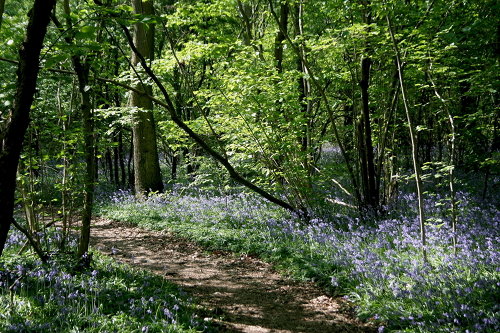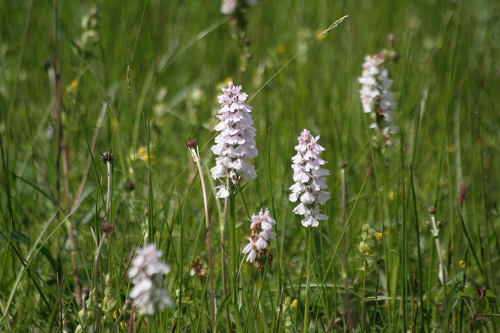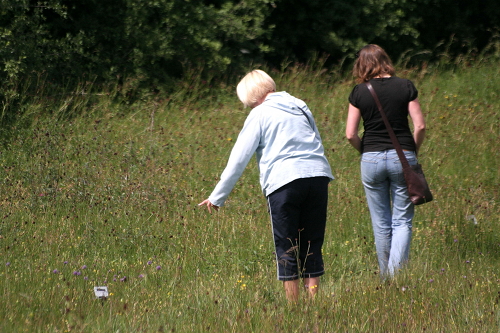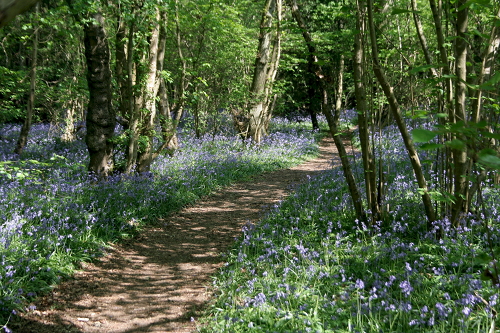Amidst the furore over the draft National Planning Policy Framework (NPPF), scant attention has been paid so far to the likely impact of the changes on biodiversity and our natural environment. Not only does NPPF pose a major threat to key wildlife sites but it also runs the risk of missing a golden opportunity to secure the recovery of England’s natural heritage on a landscape-scale.
Whilst nearly everyone would agree on the desirability of consolidating, streamlining and simplifying the overly complex planning system, our society cannot afford for this to be achieved at the expense of the natural environment and wildlife.

Bluebells in South Cubbington wood. This ancient woodland & wildlife site is currently under threat of destruction by a large cutting for HS2 near Leamington Spa. Credit: S Trotter
The planning system should provide the means by which we deliver genuinely integrated and sustainable land-use and so secure the long term public interest. Planning must embed strong and enforceable provisions for wildlife, wild places and deliver a more resilient natural environment which is better able to provide the full range of benefits and services on which society is founded.
One of the critical problems we face is the inexorable and well-documented loss of biodiversity in England – and we need to reverse the situation before it becomes an even greater disaster.

Heath spotted orchids in Monkspath Meadow. Monkspath Meadow - a local wildlife site on the edge of Solihull near the M42. Half of it was lost to a supermarket and following the controversy this half was subsequently protected as SSSI. An attempt was made to translocate the turf before it was built on - but it didnt succeed. This type of flower rich meadow is now very rare with perhaps only 200 acres surviving in the whole of Warwickshire. Credit: S Trotter
Back in June 2011, the Government announced it’s much heralded Natural Environment White Paper (or NEWP). This followed on from the abject failure of the UK to meet its international obligations of halting and reversing the loss of biodiversity by 2010. With the speed of climate change, we don’t have a great deal of time to rebuild landscapes, if we’re to avoid further major losses.
The new White Paper is supposed to mark a new era for nature conservation in England. It rightly signals a move from the traditional approach of protecting wildlife in the usually small ‘islands’ we call nature reserves … towards a landscape-scale approach in which conservation is integral to our sustainable use of the environment.
NEWP emphasises the intrinsic, economic and social value of the natural environment and endorses the need for a landscape-scale approach to securing nature’s recovery. It sets out an agenda to have bigger, better and more joined up areas for wildlife; reversing landscape fragmentation – reconnecting habitats, restoring degraded areas and providing more space for wildlife.
The White Paper was welcomed by many; myself included and it emerged from years of lobbying by The Wildlife Trusts and others. It draws inspiration from the expert and evidence-based report by the Lawton Review, Making Space for Nature, which was published in 2010.
NEWP provides the new Government with a rare chance to introduce some game-changing initiatives – and to leave a genuinely lasting legacy of which the politicians could be proud.
It sounds fantastic but as always, the fine words will be judged by what happens on the ground. The proposals must be resourced and just as importantly, the rest of government including local government, must work to implement the proposals in a consistent and coherent way alongside its civil society partners in NGOs, Agencies, individuals, farmers, landowners and local communities.
But so far NEWP is at risk of being rendered ineffective before it even gets going – undermined by the lack of resources for delivery – thanks to austerity cuts and the recession.
But all may not be lost … the National Planning Policy Framework is the first test of whether Government is taking a consistent joined-up approach. NPPF could be a key mechanism to help deliver the White Paper’s laudable aspirations and catalyse a new approach to land-use.
Again, many of the words included in the environmental section of NPPF sound ok – the intentions seem to be there but there are four key problems with the document in terms of rebuilding biodiversity and wildlife:
- the primacy given to economic development over other interests – wild places are always going to be under pressure even though the National Environment Assessment is trying to place a price (not to be confused with value) on green sites;
- the removal of any protection for local wildlife sites in the planning process places at risk some 40,000 local wildlife sites across England;
- the absence of any reference in spatial planning to the Nature Improvement Areas introduced by the White Paper – misses the opportunity to integrate the new thinking into practical delivery via planning;
- and the issue of whether the provisions for the natural environment will have sufficient ‘teeth’ to be robust enough in the face of the enhanced emphasis on economic development.
Critically, the NPPF removes completely the existing (and admittedly weak) safeguards for the network of local wildlife sites. There are around 40,000 of these local wildlife sites in England, many are small and are privately owned. Previously known by planners as SINCs (or Sites of Importance for Nature Conservation) these are vitally important places for biodiversity in which arguably much, if not the majority of England’s biodiversity outside SSSIs, now resides.
Whilst conservation’s ‘premier league’ of legally protected of SSSIs and European sites appears to be safe under NPPF (though some have cast doubt on this assumption?), the threat to local sites could be significant and far-reaching. As with the premier league in football, the ‘elite’ represent just the pinnacle at the top of the triangle. Beneath is the vitally important network of local sites which form the real backbone of biodiversity and its conservation across the UK. These are the essential building blocks for vibrant living landscapes; the reservoirs of wildlife from which nature’s recovery will come – if we wish to revitalise our natural environment.
Local wildlife sites are evaluated by local authorities and local experts using the findings of surveys, local information and knowledge. Sites are designated if they meet a suite of ecological criteria to an acceptably high standard. In fact, many of them are of an equivalent quality to designated SSSIs. We must not forget that Parliament only ever intended to provide protection for a representative selection of important wildlife sites as SSSIs – they are neither a comprehensive nor complete network.
In many areas like the Midlands with few SSSIs and few accessible natural green spaces, local wildlife sites are also often the only places where most people can see, appreciate and enjoy wildlife on their doorstep. A few decades ago, these sites would have been considered relatively ‘expendable’ in the planning process but with the continuing decline of our countryside and the frankly alarming loss of biodiversity, they are becoming increasingly important refuges for both people and wildlife.
Many local wildlife sites are also ancient woodlands. As irreplaceable and important places, it is vital that all ancient woodlands, as the crown jewels of our natural heritage, should be protected from inappropriate development in the planning process. As it currently stands the NPPF completely ignores these precious components of our national heritage – surely an unacceptable and unintended loophole which must be addressed?
At the moment, the presence of a local wildlife site or ancient woodland is a ‘material consideration’ for local authorities in determining planning applications … with a presumption against development unless there are exceptional circumstances. This is a rather weak safeguard in legal terms and in some areas Local Wildlife Sites have already been lost or irreparably damaged – one of the reasons why biodiversity loss continues apace.

This is a local wildlife site on the edge of Solihull near the M42. Half of it was lost to a supermarket and following the controversy this half was subsequently protected as SSSI. An attempt was made to translocate the turf before it was built on - but it didnt succeed. This type of flower rich meadow is now very rare with perhaps only 200 acres surviving in the whole of Warwickshire.
Nevertheless there have been many successes in protecting local sites, particularly where local authorities have adopted an enlightened approach in combination with active campaigning by local Wildlife Trusts, individuals and community organisations.

wildlife site in Nuneaton where a developer, the local authority, the Trust, local people and a contractor have worked together to creatively design a solution to an environmental problem to the benefit of wildlife - and local community. Credit: S Trotter
The removal of any protection in NPPF is likely to accelerate the loss of these key sites. It isn’t clear whether the new designation of ‘green spaces’ will cover and adequately protect local wildlife and wild places like ancient woodlands – the strong suspicion is that they will not. Local wildlife sites must be recognised and protected or English biodiversity will continue to decline and we may as well forget the good intentions of the Government’s Natural Environment White Paper!
There are some fine and welcome words in the environmental sections of NPPF. For example, about restoring habitats and ecological networks but the safeguards and provisions are simply too weak to give any comfort for nature conservationists or local people. Any developer with good representation and a determined agent will side-step with ease the vague and loosely-defined provisions. The NPPF should be strengthening not weakening the protection for these sites.
In effect local wildlife sites will fall under the ‘radar’ of the planning process and become vulnerable to exploitation and development.
Government needs to recognise that biodiversity is not necessarily a barrier to growth or business. As a Wildlife Trust in Warwickshire, we scan in the order of 2000 – 3000 planning applications per year across our patch. On average we identify fewer than 200 which need further investigation. Of these, only around 100 applications will spark any comments. Of these, perhaps only 20 or so (around 1%) are likely to have a really significant impact on biodiversity and many of these can usually be resolved satisfactorily for all parties through discussion, liaison and planning conditions. So let’s keep the issue of biodiversity being a constraint to development in perspective – it’s a relatively small issue in most cases and not a barrier to the vast majority of planning applications.
It is also clear that where enlightened developers take time to plan and integrate biodiversity and business together – there can be benefits to both. Greener developments, where biodiversity is an integral part of the design, are more valuable because they are so much more pleasant places to live and work. They attract business and workers to them because of the quality of their environment. They can also be used by developers to show their green credentials and bring kudos and a sign of quality to their business which can have an impact in securing future business.
We already have many of the practical techniques required to effectively and creatively integrate ecology and development. It’s not usually difficult and often not expensive, what’s needed is the desire to take a creative approach to planning and design from the outset. Business could really lead the way in rebuilding the nation’s natural network as a by-product of development – and NPPF ought to be setting some high standards.
Responsible and forward thinking developers readily adopt this approach – but it’s important that the NPPF underpins this by requiring all developers to adopt a responsible approach. As it stands the document simply isn’t tight enough to deal with cases where there is a market failure to deliver quality development. NPPF needs greater teeth with which to ensure that planning delivers development in a balanced and genuinely sustainable way – and genuinely mediates fairly between different legitimate interests.
It’s not a question of whether we have either development or wildlife – we need and must deliver both. It’s a question of having the right development, in the right place and integrating the wildlife and ecology with development.
In the words of Caroline Spelman, Secretary of State at Defra, speaking at a conference in Coventry in September: “we need to be green and growing”.
The Government should:
- remove the primacy given to economic development in the draft NPPF and reinstate the need to balance development with other important considerations such as the natural environment;
- require local plans to identify Nature Improvement Areas (NIAs) and other landscape scale initiatives. The NEWP introduced the concept of NIAs: large areas where nature’s restoration would have greater priority. Land use planning will be critical to achieving NIAs and yet they have no mention in the draft NPPF;
- give adequate protection for Local Wildlife Sites (LWS) and all ancient woodlands.
- Tighten the wording of NPPF to ensure that local authorities take seriously the delivery of environmental responsibilities and aspirations as set out by the NPPF – and to enable them to be held to account by their local communities for their performance on environmental and biodiversity matters.
Stephen Trotter
Chief Executive of Warwickshire Wildlife Trust but writing here in a personal capacity.





























